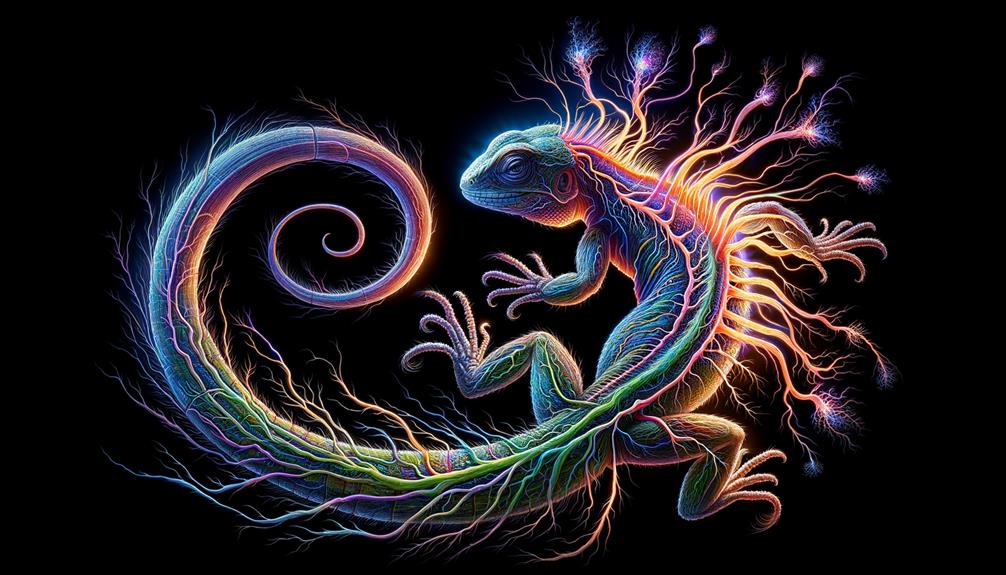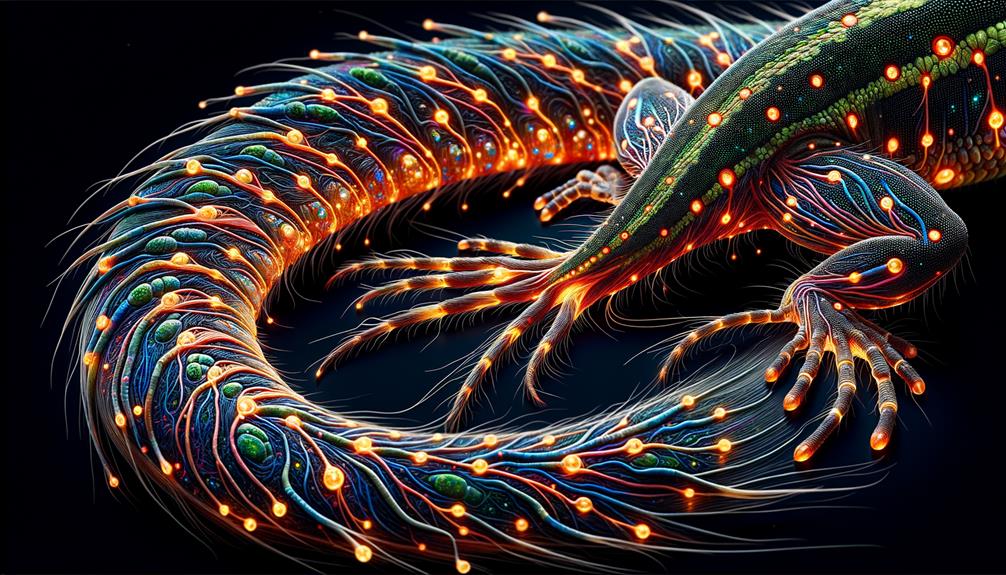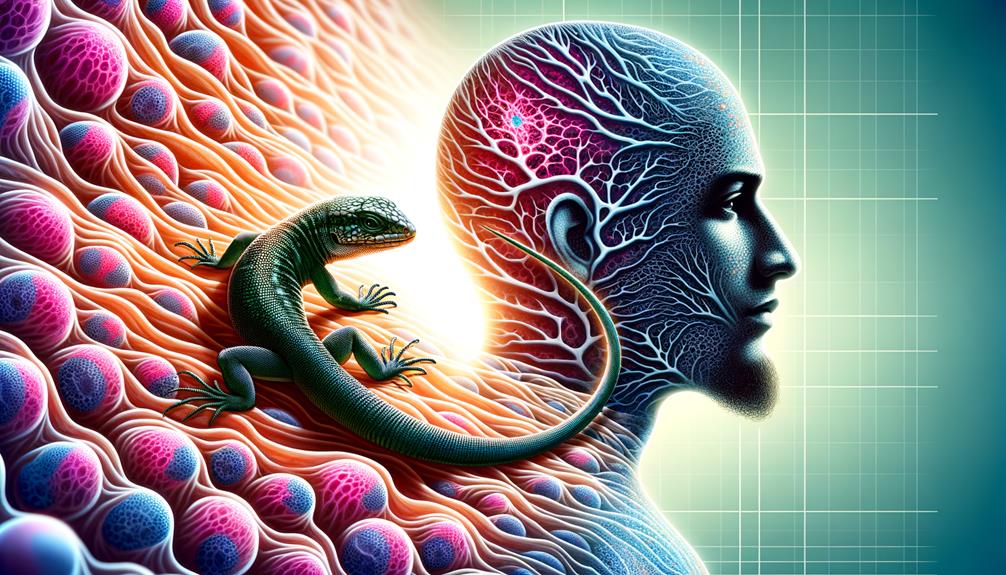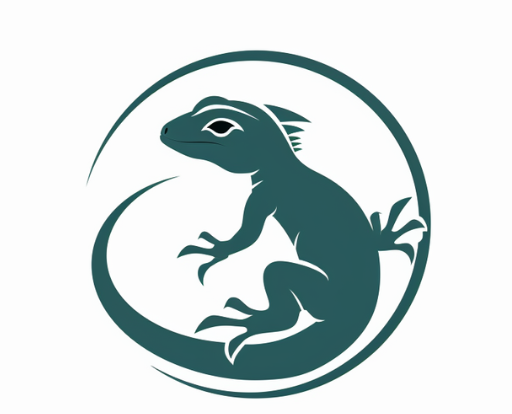The way lizards regrow their tails is pretty amazing. After a lizard drops its tail, special muscle cells start multiplying like crazy. These cells, along with a bunch of other unspecialized cells, work together to rebuild muscle and bone. The process is guided by important cellular signals. As nerves regrow, the lizard can use its new tail properly. The spinal cord connects with fresh muscle and cartilage, which could give scientists ideas for human treatments down the road. All these parts working together let the lizard fully control its brand-new tail. Scientists are still figuring out all the details of this cool ability.
Muscle Stem Cell Transformation
Lizards have a remarkable ability to regrow their tails, and it's all thanks to some pretty special cells. These muscle stem cells, also known as satellite cells, are the real MVPs of the regeneration process. When a lizard loses its tail, these cells spring into action, multiplying rapidly and following a complex set of biological instructions.
One of the coolest parts of this process is the formation of something called a blastema. It's basically a cluster of cells that haven't decided what they want to be when they grow up yet. This group includes muscle stem cells and ependymal cells, which work together to rebuild the tail.
Inside this blastema, there's a lot going on. A key player is the hedgehog signaling pathway, which sounds like something out of a video game but is actually a crucial biological process. It helps guide the muscle stem cells, making sure they turn into the right kind of muscle tissue.
As the new tail grows, these satellite cells become part of the structure, helping to form fully functioning muscle. It's like watching a tiny construction site where all the workers know exactly what to do.
For anyone who's ever been amazed by the body's ability to heal itself, this process is pretty mind-blowing. It shows just how clever nature can be when it comes to fixing things that are broken.
Nerve Regrowth Significance

Muscle regeneration in lizards is remarkable, but nerve regrowth is just as crucial for a fully functional tail. Without proper nerve connections, the new tail would be useless. This process has big implications, especially when thinking about spinal cord injuries in humans.
Scientists studying lizard tails have found that these reptiles can regrow their spinal cords in ways we're only beginning to understand. It's a complex dance of cells and molecules that allows new neurons to form and broken spinal cords to reconnect. Stem cells are key players, turning into the nerve cells needed for feeling and movement.
Learning about this could lead to groundbreaking treatments for people. If we can figure out how lizards do it, we might be able to help people with spinal cord injuries regain movement. The lizard's ability to fix its own spinal cord gives us a roadmap for what might be possible. By cracking this biological code, we could be on the path to giving many people back their mobility.
Neuromuscular Junction Patterns

Looking at how nerve connections work in new lizard tails is pretty cool. The fresh muscle doesn't just hook up with nerves again – it actually gets more connection points. This might help the lizard control its tail better. What's neat is how the muscle fibers line up, which is a lot like what happens when other animals grow. It shows just how complex it is for a lizard to get its tail moving properly again.
The way these tails rebuild themselves gives us a peek into how bodies can repair and regrow. Scientists are always trying to figure out the tricks nature uses to fix things. Maybe one day, what we learn from lizards could help people recover from injuries faster.
It's amazing how animals can adapt and overcome challenges. Lizards losing and regrowing tails is just one example of how resilient nature can be. There's still so much to learn about how different creatures heal and rebuild themselves.
Synaptic Connectivity Changes
When a lizard loses its tail, an impressive process of nerve regrowth begins. This isn't just about replacing lost tissue; it involves intricate changes in how nerve cells connect and communicate.
The regenerating spinal cord forms a central tube, which acts as a framework for new nerve cells. As healing progresses, these cells move into place and form new connections, bridging the gap between the old and new parts of the tail. These changes in nerve connections are key to restoring function, allowing the lizard to control its new tail effectively.
What's particularly interesting is how this research might apply to human medicine. By understanding the molecular processes behind lizard tail regrowth, scientists might find new ways to encourage spinal cord healing in other animals, including humans. This could lead to groundbreaking treatments for spinal injuries, offering new possibilities for recovery.
The way nerve junctions reorganize during tail regrowth provides valuable insights. It shows how flexible the nervous system can be, adapting to significant changes and forming new pathways. This adaptability is crucial for the lizard's survival and could hold lessons for addressing nerve damage in other species.
Studying these processes in lizards might seem far removed from human medicine, but nature often provides unexpected solutions to complex problems. The more we learn about how different animals heal and regenerate, the better equipped we'll be to tackle similar challenges in human health.
Muscle Fiber Reorganization
When a lizard grows back its tail, the way muscle fibers reorganize is key to getting the new tail working properly. This is especially true for green anole lizards. The process isn't just about regrowing a lifeless appendage; it's about creating a fully functioning tail.
The cells involved in this rebuild are pretty impressive. They work together to recreate muscle tissue, hook it up to the spinal cord, and blend it seamlessly with new cartilage.
Where nerves meet muscle cells, called neuromuscular junctions, connections need to be re-established precisely. This ensures the lizard can move its new tail. Some key parts of this process include:
- Getting new muscle fibers to line up correctly with nerve fibers
- Different types of cells, like satellite cells and myoblasts, teaming up to form new muscle
- The spinal cord sending signals to the new tail so it moves in sync with the rest of the body
- New cartilage giving support to the muscle structure, making it both stable and flexible
This complex cellular process shows just how remarkable these reptiles' ability to regrow body parts really is.
Skeletal Regrowth Mechanisms

Lizards possess an extraordinary ability to regrow their tails, thanks to complex skeletal regeneration processes. This feat centers on blastema-based renewal, which coordinates the formation of fresh cartilage and bone. The process kicks off with a blastema—a cluster of cells that jumpstarts regrowth. These cells then transform into various tissues, including cartilage surrounding the newly formed spinal cord.
In the tail's upper regions, this cartilage behaves similarly to growth plates, undergoing a transformation akin to endochondral ossification. This means the cartilage gradually turns into bone, creating new vertebrae that smoothly join the existing skeleton. The cartilage tubes in the lower tail, however, remain flexible throughout the lizard's life, providing both support and bendability without hardening.
Stem cells in the periosteum play a key role in skeletal regeneration. When a break occurs, these cells spring into action, stimulated by the injury site. They multiply and change into cartilage, guided by processes reminiscent of embryonic bone formation. This ensures a well-coordinated regrowth. Notably, this regenerative ability wanes with age, making adult lizards valuable subjects for studying skeletal renewal mechanisms. Through their unique capabilities, lizards offer rich insights into the intricate interplay of cellular and molecular events underlying skeletal regeneration.
Signal Regulation in Regeneration

When we dig into how skeletons regrow, we naturally wonder about the signals that control this amazing ability. For lizards regrowing their tails, several key factors work together to ensure everything forms correctly.
The group of cells at the regrowth site, called the blastema, heavily relies on signals from the spinal cord, including Shh, to start and manage cartilage tube formation. These signals are crucial for guiding cartilage development in a specific pattern. You can see this process clearly in regenerated lizard tails, where the cartilage closer to the body comes from the outer layer of the original tail bones, while the farther parts form from blastema cells responding to Shh signals from the new spinal cord.
Cells from the bone's outer layer play a vital role here. When scientists treat these cells with Ihh and BMP-2 in the lab, they can mimic how the cartilage forms naturally, showing how important these signals are.
Key points:
- Shh signals from the new spinal cord trigger cartilage formation at the tail's end.
- Cells from the bone's outer layer are crucial for cartilage development near the body.
- Treating these outer bone cells with Ihh and BMP-2 copies natural cartilage formation.
- Putting spinal cord tissue into blastemas can cause unexpected cartilage tube growth.
This complex dance of signals shows just how sophisticated lizard tail regrowth really is.
Implications for Human Therapy

Lizards' remarkable tail regeneration abilities have scientists wondering about potential applications in human medicine. The regrown tail skeletons could offer insights for developing new approaches to spinal injuries. Scientists at Arizona State University are studying the genes and cell processes involved in this fascinating phenomenon.
Their team found that tail regrowth involves complex steps, including spinal cord repair and cartilage formation. Understanding these processes could lead to new treatments for spinal injuries in humans. The parts of the tail closest to the body provide valuable information about how cells can change their function and multiply effectively.
| Feature | Lizard Tail Regrowth | Possible Human Applications |
|---|---|---|
| Gene Activity | Controls tissue rebuilding | Specific gene treatments |
| Spinal Cord Healing | Functional spinal cord regrowth | Spinal injury therapies |
| Cartilage Growth | New cartilage in regrown tail | Cartilage repair methods |
This research opens up exciting possibilities for medical advances. By studying how lizards can regrow complex structures, scientists might find new ways to help people recover from serious injuries. The ability to regenerate spinal cord tissue is particularly promising for those with paralysis or other spinal cord damage.
While we're still far from regrowing human limbs, this research could lead to significant improvements in treating injuries and degenerative conditions. As scientists continue to unravel the mysteries of lizard tail regeneration, they may discover new approaches to healing that could change lives.
Frequently Asked Questions
Is It Painful for a Lizard to Lose Its Tail?
While we can't directly experience a lizard's sensations, research hints at potential discomfort during tail loss. This clever defense tactic often saves their lives. Remarkably, these reptiles can regrow their tails, adapting to life's challenges even after shedding a body part.
How Many Times Can a Gecko Regrow Its Tail?
Geckos have an amazing ability to regrow their tails, but there's a limit to this superpower. Depending on factors like species, age, and diet, a gecko might regenerate its tail up to six times. Each new tail tends to be a bit smaller than the last. This neat trick helps these little lizards escape danger, thanks to a special area at the base of their tail packed with cells that can turn into different types of tissue. It's like having a built-in escape plan that works over and over again.
How Many Weeks on Average Does It Take a Lizard to Regrow Its Tail if It Is Detached?
Lizards typically take between 8 to 12 weeks to grow back a lost tail. This process isn't set in stone, though. Different lizard species and their living conditions can speed up or slow down tail regrowth. Each lizard's experience with regeneration is unique, much like how humans heal from injuries at varying rates. Environmental factors like temperature, nutrition, and stress levels play a big role in how quickly a lizard bounces back from losing its tail. So while we can give a general timeframe, it's worth noting that some lizards might regrow their tails faster, while others might need a bit more time to fully recover.
Why Can Lizards Regrow Limbs but Humans Cannot?
Certain lizards possess a remarkable ability to regrow lost limbs. This process hinges on their cells' capacity to reset and multiply effectively. Humans, on the other hand, can't pull off this feat. Our bodies are built differently, with more intricate tissue structures and immune responses that focus on healing wounds rather than regenerating entire body parts. While this might seem like a disadvantage, it's simply how our bodies have evolved to handle injuries. Scientists are still studying these differences, hoping to unlock potential applications for human medicine down the road.



